Opportunity Solution Tree: Definition, Tips, And Overview
The Opportunity Solution Tree is one of the most effective tools product managers can keep in their arsenal. It has gained traction in recent years because of how it brought clarity and structure to the product discovery process. Ultimately, it has helped identify opportunities and craft viable and feasible solutions to solve problems and attain product outcomes.
In this article, we’ll look at one of the most popular product management frameworks today: the opportunity solution tree. We’ll discuss its definition, importance, history, and some useful benefits it offers for product teams to leverage. We’ll also teach you how to create an Opportunity Solution Tree. By the end of this article, we’ll give you some best practices and tips you can follow.
Table of Contents
What is an opportunity solution tree?
An Opportunity Solution Tree (OST) is a visual framework that helps product managers determine the best route toward an outcome. It aids them in making informed decisions while serving as a practical guide throughout the discovery process. Ultimately, it’s a product management framework that helps them identify, evaluate, and prioritize opportunities that will lead to practical solutions.
“The Opportunity Solution Tree is an invaluable tool that empowers product managers to swiftly navigate complexities and execute intelligent decisions without unnecessary distractions.”
Here’s a typical example of the framework to give you a better idea:
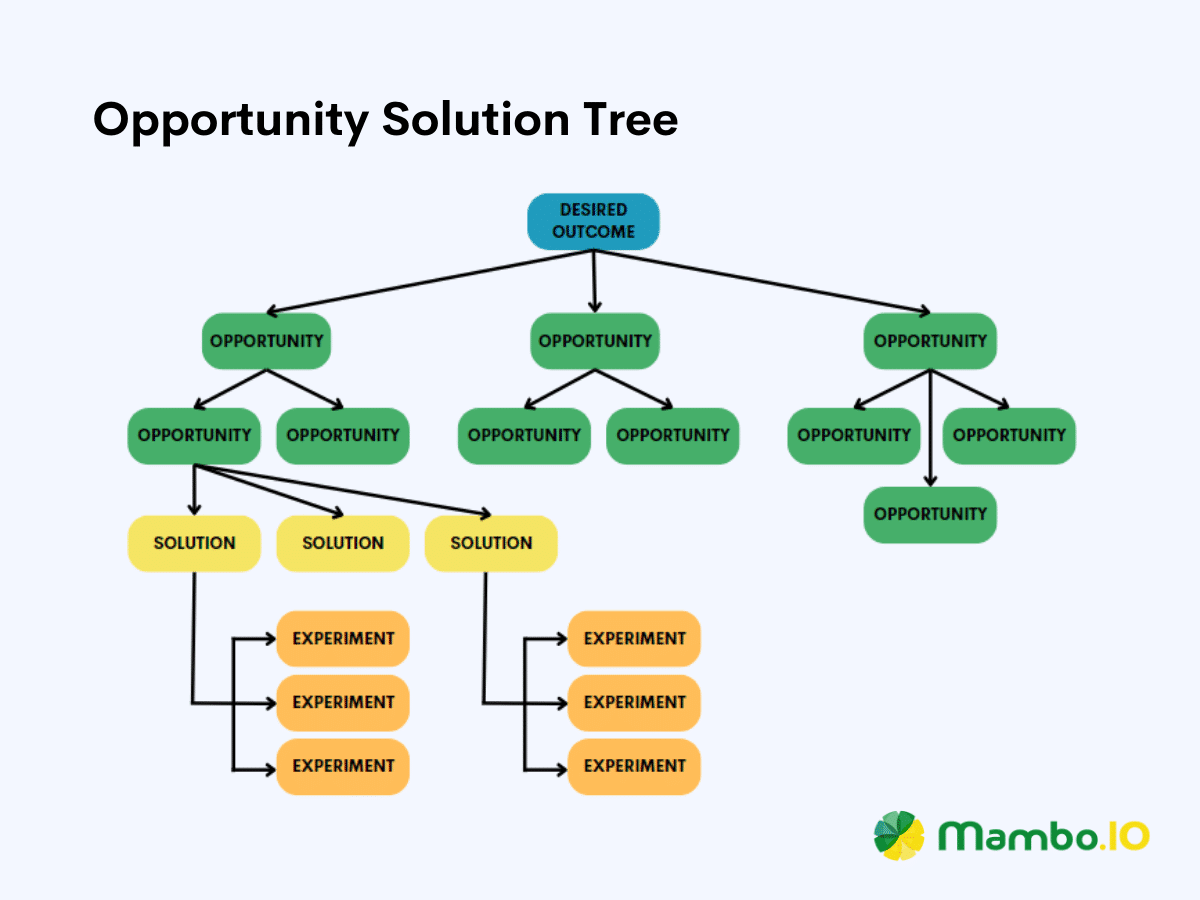
The goal of this framework is simple: to tackle the common challenges that often arise during the product discovery process. You can do so by using this framework to outline opportunities and generating ideas on capitalising on them. Think of opportunity solution trees as a GPS to guide you through the complex product development process.
History
In 2016, a practical and highly effective map type was introduced to the product management scene. It assisted many product teams in streamlining their discovery process and maintaining a clear trajectory through their ongoing discovery journey. We now know this map as the Opportunity Solution Tree, conceptualised and popularised by the prominent discovery coach Teresa Torres. And to this day, it still makes the job of many product managers 10x easier.
Torres realised that better mental representations could make people respond more quickly and effectively. Simultaneously, she recognised the need for a structured approach that product teams can follow. One that can help identify opportunities, devise corresponding solutions, and subsequently validate those solutions.
Because of this, she made the Opportunity Solution Tree specifically to make product discovery easier for product managers. Ultimately, Torres’ goal was to empower them to use visual representations to externalise their thinking and problem-solving process.
How does an opportunity solution tree work?
At this point, you’re excited to make an Opportunity Solution Tree for your team. We get it; it’s indeed a pretty helpful framework! However, to maximise the usefulness of this framework, you need to know how it works first.
Let’s discuss each part of the Opportunity Solution Tree below.
#1. Desired Outcome
At the very top of the tree sits the Desired Outcome. This is the overarching goal or result you aim to achieve through your product or solution. This serves as your “north star”, a guiding light to help you steer your decision throughout the discovery process. Ideally, the outcome should be something that the product team can directly influence.
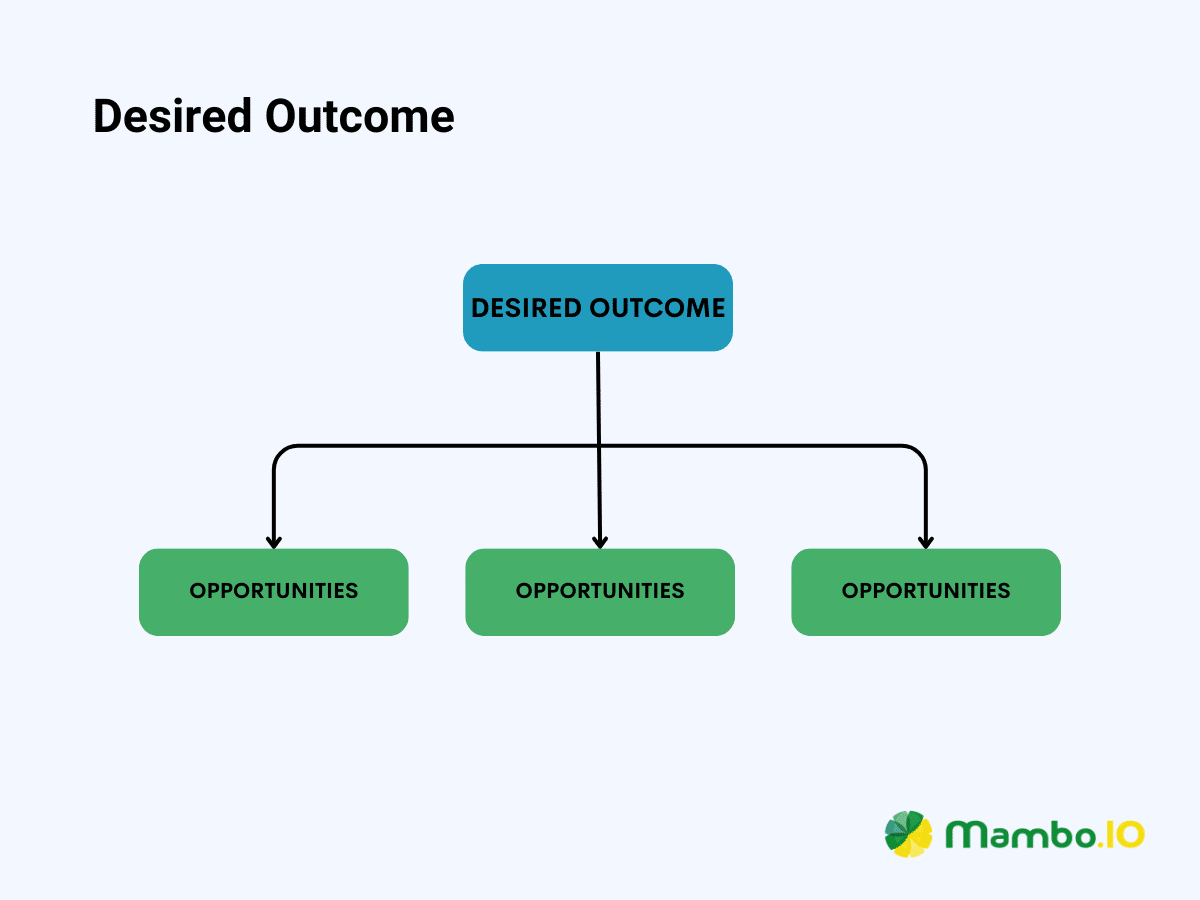
#2. Opportunities
The next layer down the tree is the opportunities. These are potential avenues or areas where you can create value to reach your outcome. Each one you’ll encounter in the opportunity space represents a strategic direction you could take to address the challenge at hand.
One effective way to come up with plausible opportunities is by asking yourself the following question:
“What problem does this product, feature, or initiative address for the customer?”
Resourceful product managers can uncover promising opportunities through research, observation, and even the collective wisdom of their team. Here are other avenues you can explore to identify ripe opportunities:
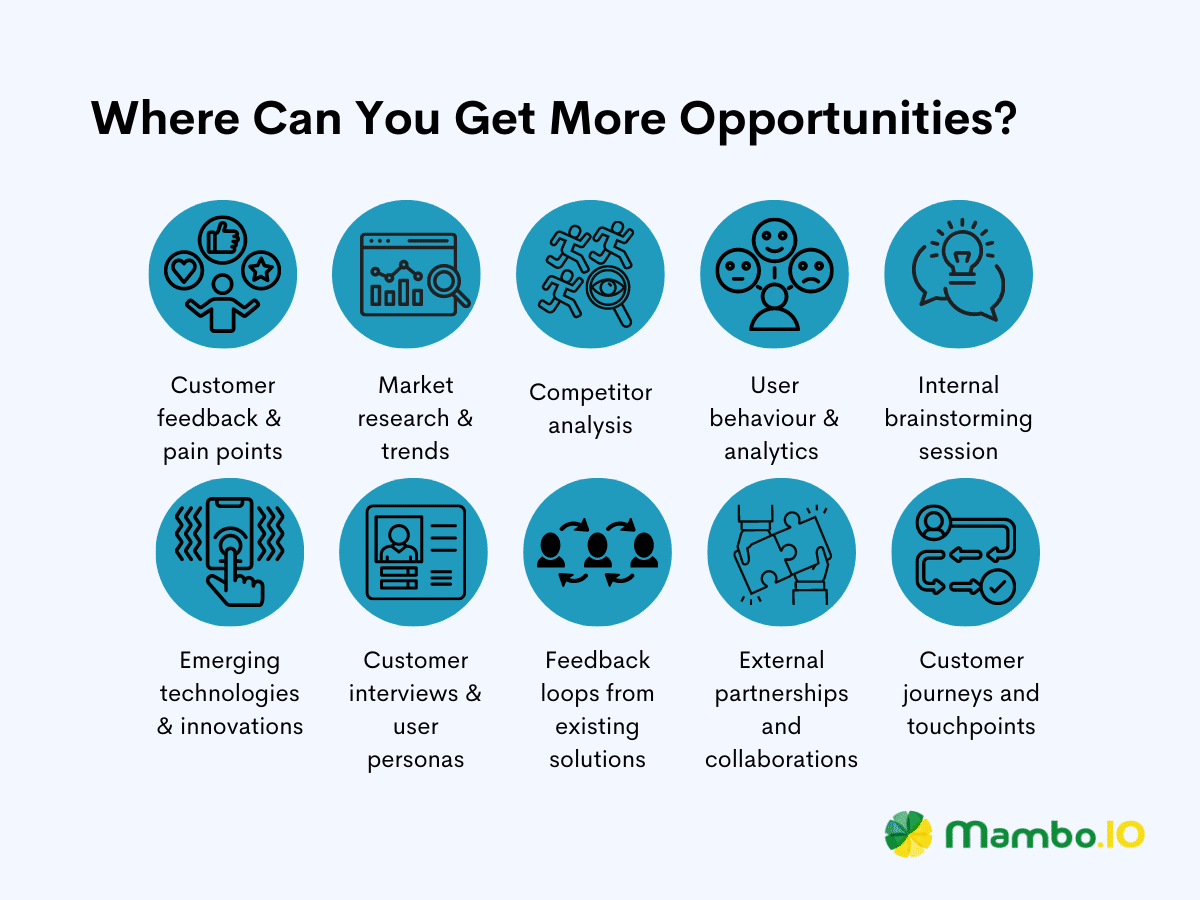
#3. Solutions
Afterwards, begin working with your cross-functional teams to list down ways you can attack the problems faced by the customers. Remember that each task is a potential path to achieving your outcome. As a product manager, you must ensure these prospective solutions are feasible, impactful, and aligned with the outcome.
8 useful tips to generate viable solutions
Here are some useful tips you should remember when generating a list of possible solutions:
- Identify solutions that directly address pain points or enhance your users’ experience.
- Encourage brainstorming sessions amongst your team members and other departments.
- Focus on solutions with the highest potential to come up with meaningful outcomes.
- Don’t settle for the first batch of solutions you generate. Iterate and refine ideas through feedback and testing.
- Strike a balance between offering valuable features and avoiding unnecessary complexity.
- Gather input from stakeholders to ensure solutions align with broader organisational goals.
- Use customer feedback, both positive and negative, to guide your solution-generation process.
- Consider how you can repurpose existing features or technologies to create new solutions.
#4. Experiments
Shipping solutions as-is is a big no-no. Doing so is expensive and harbours high risks that might damage the product development life cycle. To avoid this, you can evaluate the viability and effectiveness of these solutions through low-effort experiments. So many underlying assumptions exist for each solution, and you must test the waters before letting them sail. Doing so will let you separate the ideal solution from the faulty ones while reducing potential risks.
A little thought experiment before we proceed
Let’s consider the scenario below so you can better appreciate the importance of these components. Picture this: You’re a product manager tasked with improving a mobile app’s user engagement.
Your Desired Outcome is to increase user engagement by 20% within three months. This task can initially sound overwhelming, so you’ll have to widen your lens and identify possible opportunities to leverage.
Some ideas that may pop into mind include:
- Enhancing the app’s onboarding experience
- Gamify user interaction
- Personalise content recommendation
Each of these opportunities must have Solutions to support their viability and feasibility, such as:
- Streamline the onboarding flow
- Design personalised rewards
- Use AI-driven content recommendation
Then, you design Experiments to test these solutions:
- A/B testing the onboarding steps
- Challenge participation rate test
- Personalisation effectiveness study
Here’s what the Opportunity Solution Tree would look like for this scenario:
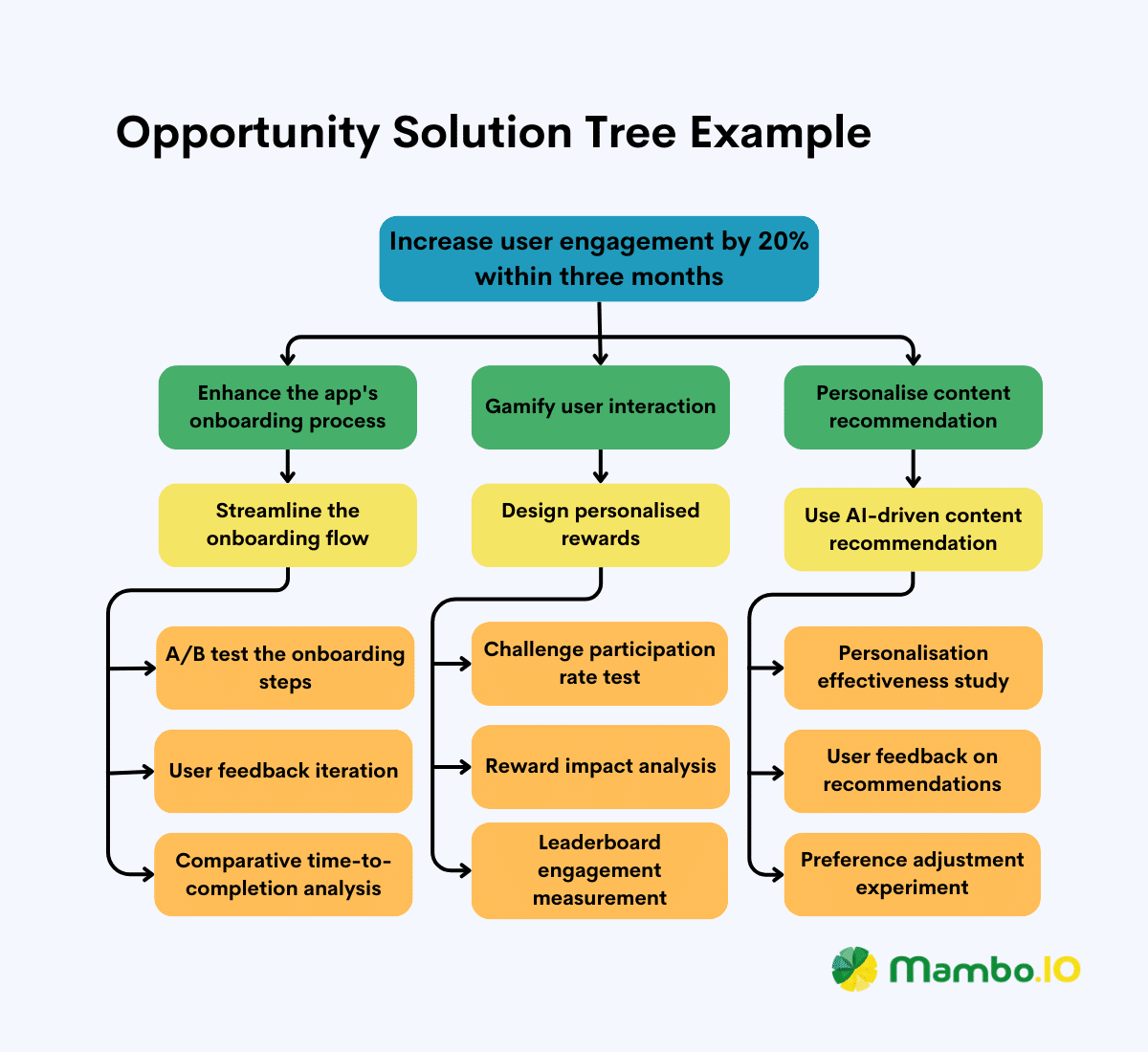
How to create an opportunity solution tree?
The whole point of the Opportunity Solution Tree is visualising product discovery and making it simple. But creating one can still be tricky. This is especially true for product managers who are new to this approach. So if you’re looking for a model you can adopt to simplify your product discovery journey, follow the steps below.
Step #1. Identify your desired outcome
A desired outcome must be at the pinnacle of any Opportunity Solution Tree template. It could be any attainable objective, such as business goals, customer satisfaction metrics, revenue targets, etc.
Ideally, outcomes are created to encapsulate the shift in customer behaviour. Choosing a strategic approach like this ensures that the customer’s viewpoint remains paramount as you begin evaluating potential opportunities.
Here are some examples of well-defined outcomes:
- Streamlined user onboarding
- Enhanced user engagement
- Data-driven decisions making
A good desired outcome is both appealing to your leadership and feasible for your product team to work around. Before concluding, do some back-and-forth between your team and the higher-ups.
Using OKRs to define the desired outcome
Using objectives and key results (OKRs) is an effective way to pinpoint your potential desired outcomes. OKRs can serve as a compass for establishing pivotal strategic goals while quantifying the progress toward their realisation.
It’s also highly likely that your product team may already have set up OKRs or similar goal structures. If that’s the case, these metrics can be a prime vantage point where you can start your efforts. But if not, it’s essential to ensure these metrics align with your organisation’s overarching goals and strategic vision.
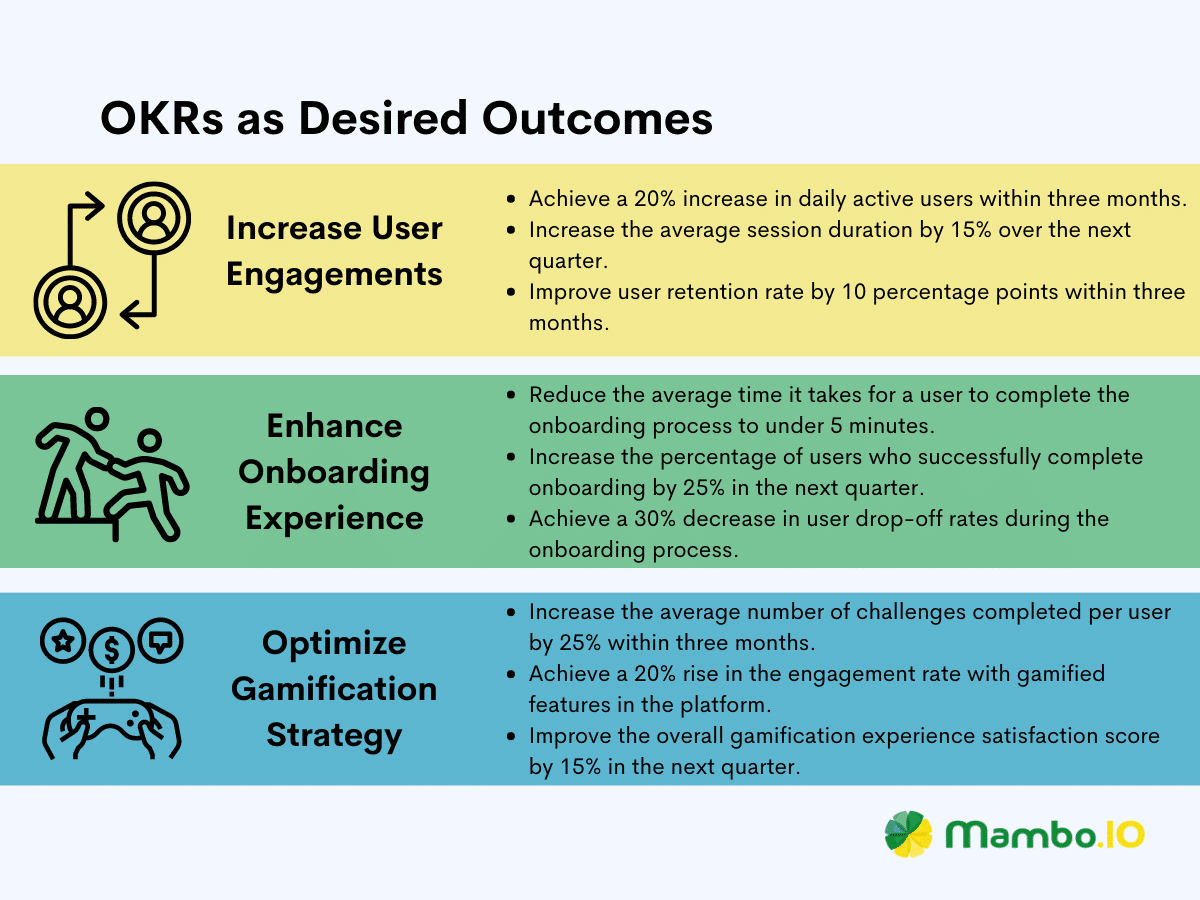
PRO TIP: Choose an attainable desired outcome. If your objectives are intimidatingly huge, you can always break them into smaller, more manageable outcomes.
Step #2. Identify your opportunities
Once your desired outcome is clear, you can identify the opportunities that align with it. The best way to do so is by thinking of opportunities as customer problems. Be sure to explore your user’s pain points, needs, preferences, and desires. More importantly, identify whatever’s driving them to act against the favour of your outcome.
There are many ways to define the ideal opportunities you can leverage. Here are two of the best:
Interviews with users
First, you can have your product trio interview existing and potential users. This trio comprises the product manager, design lead, and tech lead (we’ll discuss this further later). Together, these people are best positioned to identify the opportunities that will impact the desired outcome most.
Collect user feedback through micro-surveys
You can also distribute micro-surveys (CSAT, NPS, CES, PMF) and collect valuable user feedback from them. Then, use analytics functionalities to identify the patterns in user behaviour. Customer feedback tools like Userpilot can help you collect feedback using micro surveys.
After you’ve gathered enough opportunities, the next step is to validate and prioritise them. Doing so lets you pick out the ones that offer the most significant potential impact on your product outcome. You can use prioritisation frameworks like Opportunity Scoring and Cost of Delay to help you in this scenario.
Here are examples to give you a better idea of what opportunities should look like:
- Enhance user onboarding experience
- Reduce cart abandonment
- Personalise content recommendations
- Reduce churn rates
- Increase performance speed
Step #3. Identify solutions that align with your opportunities
With your opportunities lined up, it’s now time for you to find ways to solve them. In this step, you must open up the space and go wide with your solution discovery process. Often, the first solutions you’ll come up with could be better. However, great ideas tend to present themselves as you force yourself and your product team to generate ten ideas or more.
Generating solutions in the most interactive way
Additionally, don’t hesitate to let the most important people get involved with the process. We’re talking about the stakeholders, other teams, and your users. You’d be surprised to know that great ideas can come from anywhere. So, don’t hesitate to call for brainstorming sessions to generate plausible solutions.
Lastly, you’d need to evaluate and prioritise your gathered solutions. You should invite everyone for a round of Priority Poker so everyone can contribute their views without superimposing on others.
Here are the corresponding solutions to the opportunities presented earlier:
- Interactive onboarding tutorials
- Simplified checkout process with one-click purchases
- Content recommendation engine based on user preferences
- Gamification
- Content-caching and content delivery network (CDN) implementation
Step #4. Test your solutions to find ones that work best
Now comes the strategic step of making the Opportunity Solution Tree. Once you’ve evaluated and prioritised your solutions, your next step should be designing experiments to test the most promising solutions. By testing the assumptions behind the solutions, you can determine whether it can help achieve your desired outcome.
Here are some proven and tested strategies you can employ to test your solutions:
- Rapid prototyping
- A/B testing
- User interviews
- User surveys
- Usability testing
- Beta testing
- Competitor analysis
- Metrics monitoring
- Pilot programs
- Feedback loops
Create opportunity solution trees with this software
Opportunity Solution Trees may sound like a simple framework, but they’re not easy to make. But here’s the good news: you don’t have to make them from scratch. You can always use a pre-made opportunity solution tree template available online. You can also use the software below to get started with your first maps for your team.
#1. Miro
Miro is a versatile online collaborative platform that enables teams to create Opportunity Solution Trees using customisable templates. Its real-time collaboration features make it one of the go-to software for product managers and their cross-functional teams.
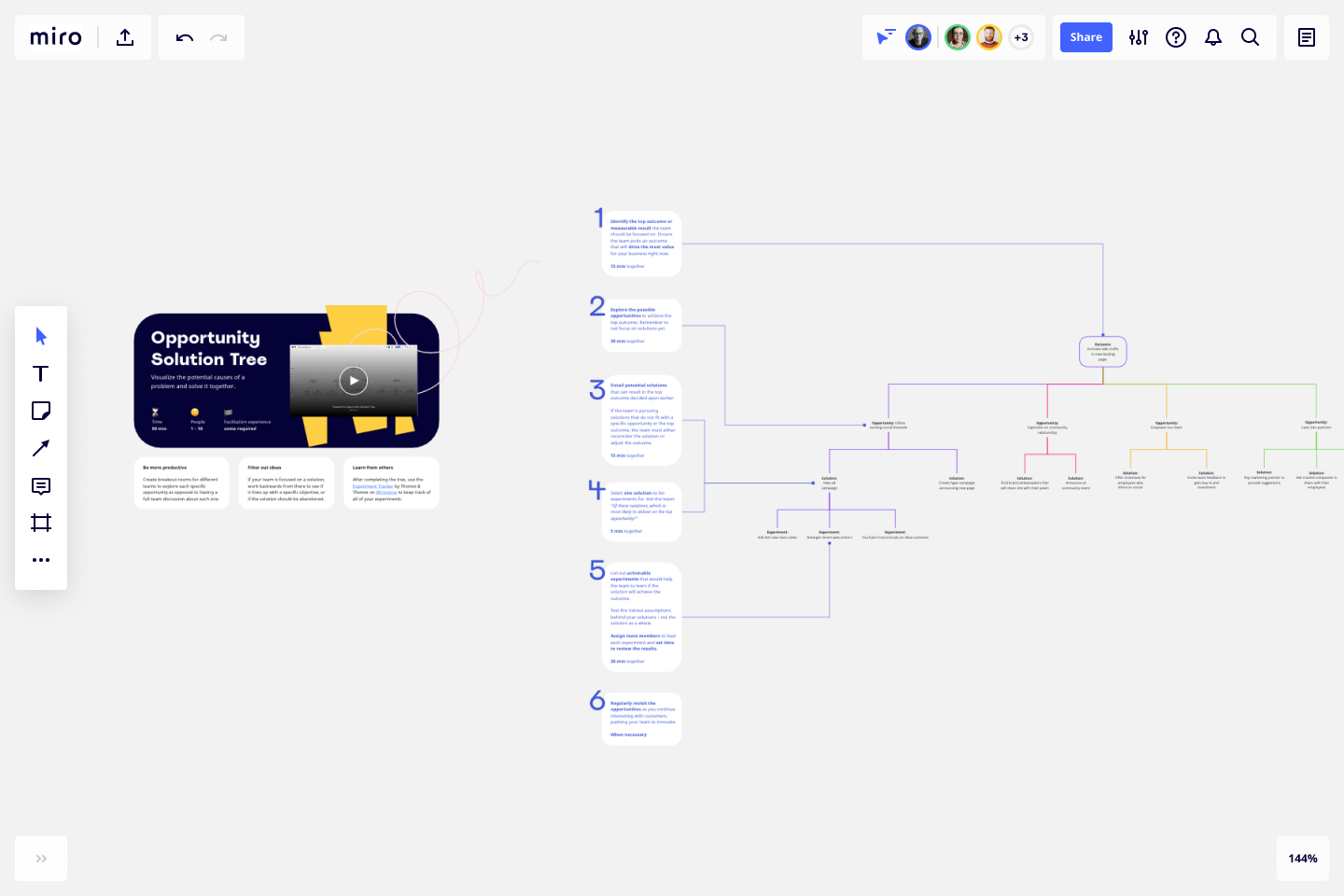
Source: Miro
#2. Lucidspark
Lucidspark offers an intuitive environment where you can easily create Opportunity Solution Trees. It offers critical features that can simplify the process, such as intelligent diagramming, breakout boards, and more.
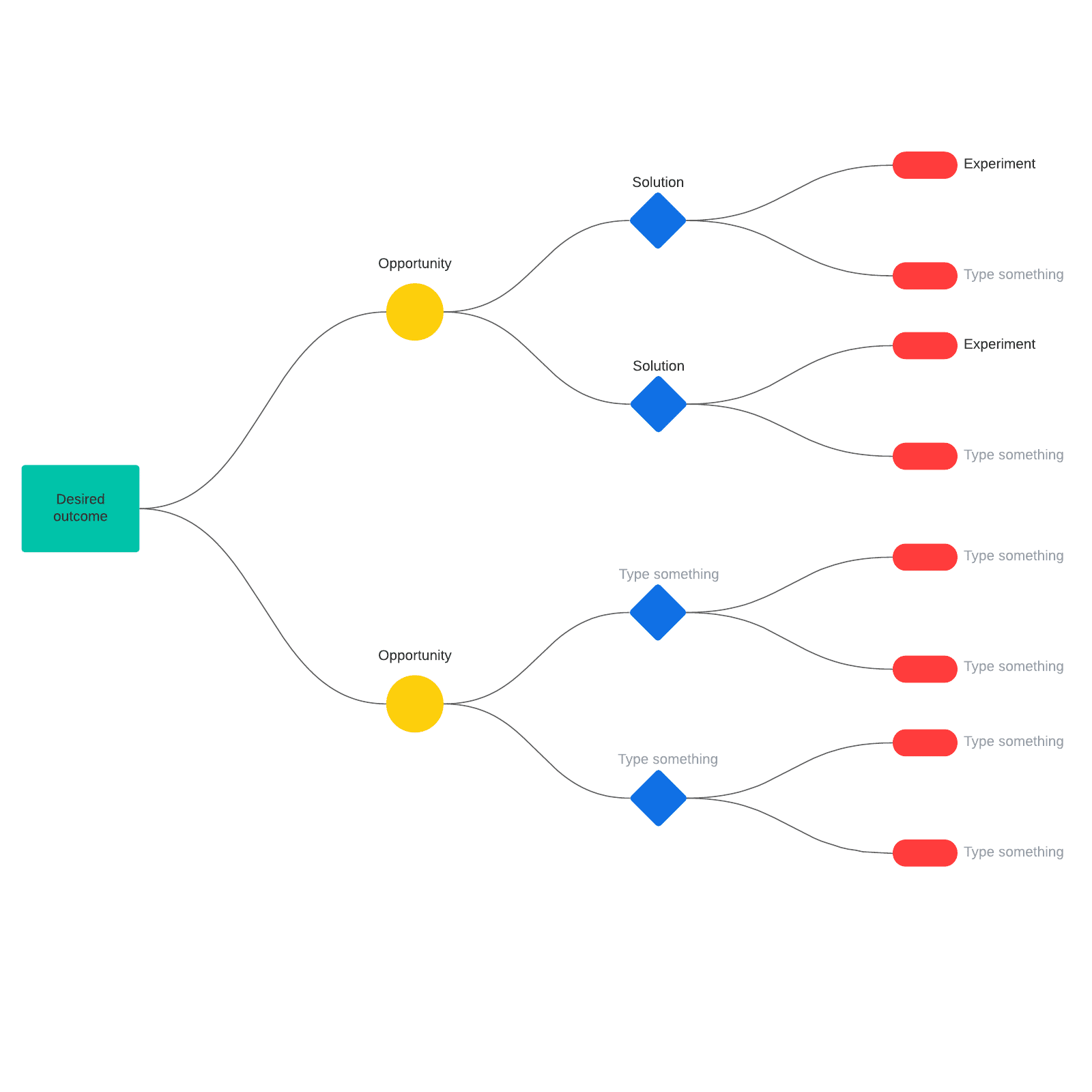
Source: Lucidspark
#3. Whimsical
Whimsical software combines diagramming, collaboration, and whiteboarding, which are important when making an Opportunity Solution Tree. It offers a minimalist approach that doesn’t compromise on functionality.
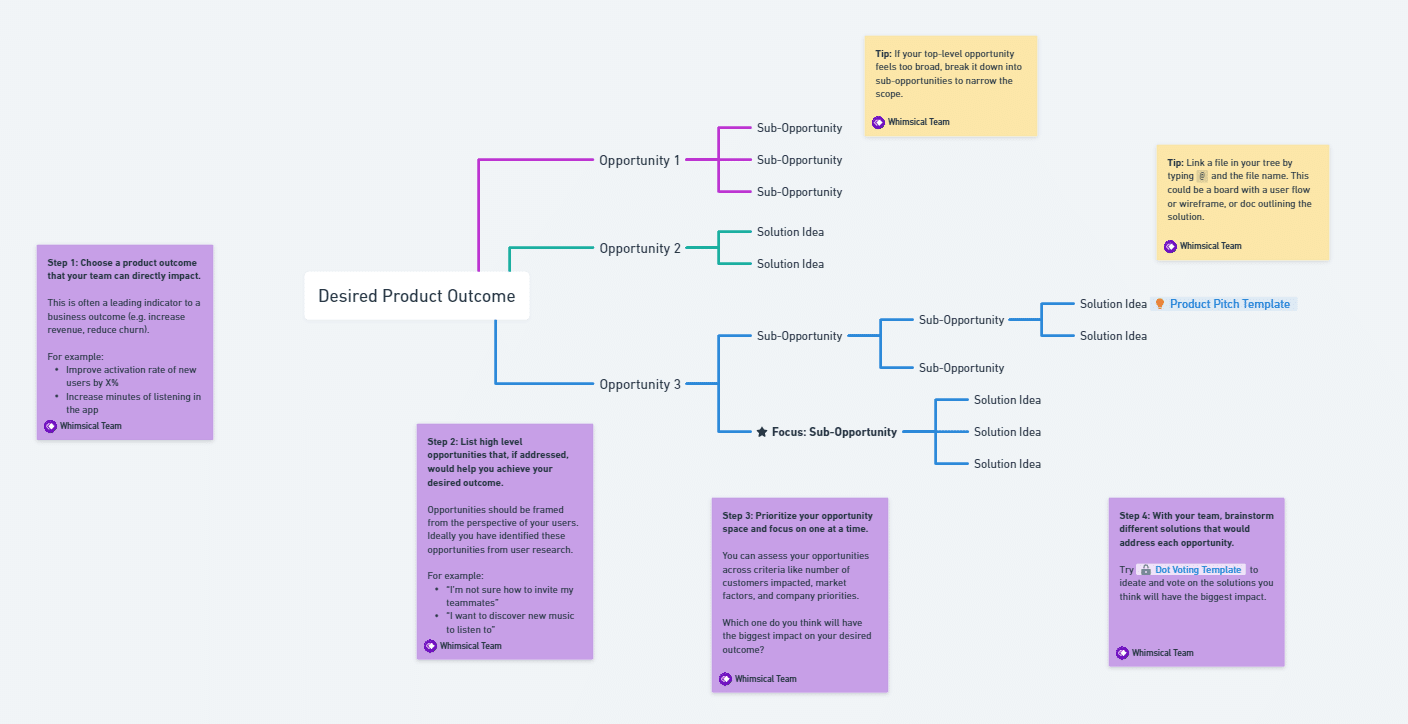
Source: Whimsical
#4. MindMeister
MindMeister is a mind-mapping tool that can help you visually map out the Opportunity Solution Tree. It promotes collaboration within product teams with easy sharing options and seamless integrations.
#5. Xmind
Xmind is a popular mind mapping and brainstorming tool that offers a flexible canvas for creating Opportunity Solution Trees. It has various diagramming styles and export options, making it a reliable choice for product managers who need clarity.
Why use an opportunity solution tree?
The Opportunity Solution Tree is a product management framework that can significantly enhance your problem-solving approach and decision-making. Many product managers can attest to the usefulness of this framework. More importantly, it’s responsible for some of the successful products people know and love today.
Here are some of the benefits of using the Opportunity Solution Tree, according to Teresa Torres. We’ll discuss each of these benefits further later on.
#1. It resolves the tension between business needs and customer needs.
Finding the delicate balance between business priorities and the customer’s genuine needs is a constant challenge for product managers. This framework can act as a bridge, helping product managers like yours to identify potential solutions that align with both sides. With it, you can visually pinpoint areas where opportunities and solutions intersect, therefore minimising conflicts and maximising value.
#2. It helps product teams build a shared understanding of how they can reach the desired outcome.
Collaboration with product teams is critical, but keeping everyone on the same page is challenging. Fortunately, the Opportunity Solution Tree template can become the focal point of discussion for everyone involved. It encourages your team to collectively explore opportunities, analyse solutions, and come to a shared understanding of the path forward. Such alignment promotes better teamwork and fewer misunderstandings, which enhances overall productivity.
#3. It helps product teams adopt a continuous mindset.
Embracing a continuous mindset is important to survive the ever-evolving product landscape. Thankfully, the Opportunity Solution Tree encourages iterative thinking. It prompts you to revisit and update the tree regularly with new insights to improve your solutions accordingly. With this iterative process, you can ensure your strategies remain agile to respond swiftly to changing market conditions and opportunities.
#4. It unlocks better decision-making.
Product managers know how crucial it is to make the right decisions. They’ll need a structured framework like the Opportunity Solution Tree to ensure they’re making the right choices. It offers a methodical approach that can empower them to make informed decisions backed by solid data.
#5. It enables faster learning cycles.
Effective product managers learn from both success and failure. With the Opportunity Solution Tree, you can accelerate your learning cycles through experimentation. This rapid feedback loop can refine your approach and help you adapt efficiently to market dynamics.
#6. It helps build confidence in knowing what to do next.
Product management is uncertain, but the key is to use frameworks like this as your guide. It provides a clear roadmap of potential solutions so you can feel more confident about your steps.
#7. It unlocks simpler stakeholder management.
Managing various stakeholders with diverse interests is a challenging feat. But with the help of Opportunity Solution Trees, you can easily streamline this process. Your strategy’s visual representation can be a powerful tool to help you communicate your decision-making rationale to stakeholders.
When to use an opportunity solution tree?
Torres made this phenomenal framework to help product managers and their teams visualise their thinking. It makes the product discovery process more straightforward by organising potential areas of opportunity where the company can invest.
So when is the best time to use an Opportunity Solution Tree?
Since it’s a versatile tool, you can use it as an input for any roadmapping exercise. Its flexibility and visual nature make it particularly useful for situations such as:
- Idea generation
- Problem validation
- Decision-making
- Iterative planning
- Communication and alignment with cross-functional teams and stakeholders
- Product road mapping
- Continuous improvement
Who should own the opportunity solution tree?
Torres considers the product trio as the owners of the Opportunity Solution Tree. Her rationale behind this thinking is simple: everyone is responsible for all the risks of building a product.
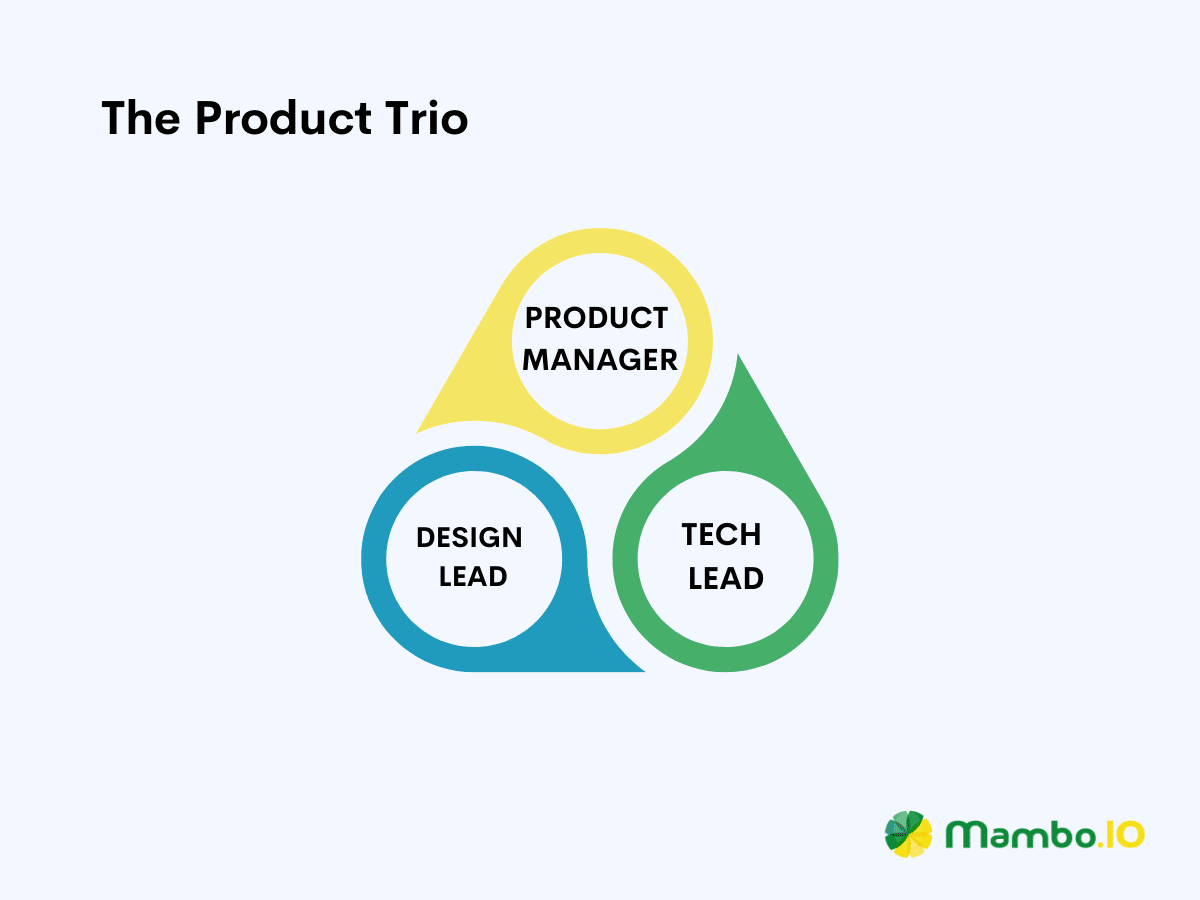
The product manager may be in charge of managing the product from idea to launch. However, the Tech Lead handles the technical aspects of the product and leads the engineering team. Don’t forget the Design Lead that shapes the product’s user experience and interface.
If each of them owns the tree, their interests will inevitably clash. If this scenario happens, collaboration becomes impossible, and nobody wins, not even the product itself.
Opportunity solution tree best practices
Are you impressed with the Opportunity Solution Tree and planning to integrate it with your workflow? If you are, we’d like to leave you with some of these best practices so you can fully maximise this revolutionary framework.

Wrapping Up
The Opportunity Solution Tree framework has been instrumental to the success of many product teams today. With this framework, product managers and their teams can adopt a new and practical approach to product discovery. It also offers many benefits that help them cut focus on opportunities and potential solutions that can impact their desired outcome the greatest. Ultimately, it changed how teams work by offering them a visualised path to achieve their desired objectives.
Latest Posts
Machine Learning In Finance: 12 Essential Applications
The impact of machine learning on finance is significant. Thanks to this technology, financial institutions are now equipped to make efficient decisions. Through the analysis of data sets, machine learning […]
How To Create Interactive Compliance Training For Bank Employees
Banking compliance training isn’t just another task. It’s the stage where everything else performs. Banks must navigate a myriad of regulations and laws. After all, this is a trust-driven, high-stakes […]
How Fintech Apps Are Using Gamification To Increase User Engagement
Discover how gamification in fintech is revolutionizing financial engagement, making banking fun & boosting user loyalty.




